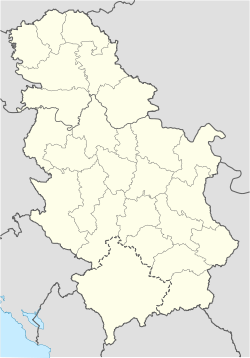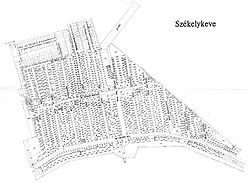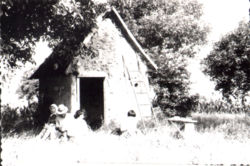- Skorenovac
-
Skorenovac
Скореновац
SzékelykeveSzékelykeve Coordinates: 44°45′42″N 20°54′21″E / 44.76167°N 20.90583°ECoordinates: 44°45′42″N 20°54′21″E / 44.76167°N 20.90583°E Country Serbia District South Banat Municipality Kovin Population (2002) – Total 2,501 Postal code 26228 Area code +381 13 Car plates PA Skorenovac (Serbian: Скореновац, Skorenovac, Hungarian: Székelykeve, German: Skorenowatz, Banat Bulgarian: Gjurgevo) is a village located in the Kovin municipality, in the South Banat District of Serbia, in the Autonomous Province of Vojvodina.
Contents
Geography
The closest towns are Kovin (6 km), Smederevo (17 km), Pančevo (30 km), and Belgrade (46 km).
History
General history
The village named Gyurgyova-Rádayfalva (Đurđevo) existed between 1869 and 1886 at the location between Banatski Brestovac and Danube river. In 1869, the population of Gyurgyova numbered 396 people. After initial settlement, which included Hungarian (Palóc) families from Banatsko Novo Selo (hun: Újfalu), Jermenovci (hun: Ürményháza), Sándorfalva, Szeged county and Banatski Dušanovac (hun: Szőlősudvarnok, ger: Rogendorf), in 1883 came the first Székely settlement with total of 645 families or around 2,000 individuals.
Later, in 1886, the population of this village was resettled to the location of present day Skorenovac and Ivanovo. The reason for resettlement to Skorenovac and Ivanovo was the flooding of the Danube river and the yearly annihilation of property in the village and its agricultural land. At the same time, the inhabitants' lives were in constant danger.
The village of Skorenovac (named Székelykeve in that time) was founded in 1886, during the time of Franz Joseph I. In the time of the village settlement, its territory was situated in the Torontál Vármegye (County) of the Kingdom of Hungary. In 1912 it was situated in the Temes Vármegye (County). In 1888 it had 506 houses and in 1910 the village had 685 houses.
The majority of the original settlers were Székely Hungarians who came from Bukovina, and also, in the same time frame, some German families from Plandište and Pločice and some Bulgarian families from Dudeştii Vechi (hun: Óbesenyő, ger: Altbeschenowa, Banat Bulgarian: Stár Bišnov) аre settled in Skorenovac. Skorenovac is the southest place with Hungarian national majority.
Historical names of the village and region
Historical names of the region:
- Zkorenovetz Terra (1412)
- Zkorenocz Puszta
- Villa Regalis (1428)
Historical names of the village:
- Nagygyörgyfalva (1883–1886)
- Székelykeve (1886–1922)
- Skorenovac (since 1922)
- Skorenowatz (Used by Germans in different periods)
Economy, Religion, and Education - Timeline
- 1885 - The first steady teacher came to the village of Gyurgyova (then in 1886 to Skorenovac). His name was János Mischel.
- 1886 - The first judge and mayor of Skorenovac was Ágoston Kollár (1886–1890).
- 1889 - The school building was finished. The teachers in the school were: Johan Steiner (Principal and teacher), János Mischel (teacher), Ottilia Müller (teacher), and Etelka Somogyi (teacher). In school year 1905/1906 school had 561 students. Elementary school, in that time, was up to grade 6. School Board members in 1930's were Imre László, Mihály Fehér, Francz Wintergerst, Bóna Boszilkov, József Medgyessy and András Varga.
- 1892 - December 18, a Church (Roman Catholic) was erected. The first priest was Ferenc Deleme (1892–1898).
- 1894 - November 25, foundation of the Farmers Creditors Collective. Its president was Fr. Ferenc Deleme, and the collective had 71 members.
- 1895 - October 6, Library was founded, and had a 50 members. President was Ferenc Deleme, while the librarian was János Hajagos.
- 1898 - The first "shared" doctor in the village, Dr. József Klein.
- 1899 - The voluntary fire brigade was established; its president was Johan Kirchgäsner and the fire chief was Johan Mischel, while the brigade had 60 members.
- 1900 - The first permanent doctor, Dr. Edét Urbanek, arrived in the village.
- 1906 - Hunters association founded, with 14 members. Founders were Gyula Szabatka and Dezsö Töry.
- 1912 - The first motorized "Big Mill" is opened, owned by Katalin Rüger. It worked until the mid-1970s, when it was closed.
- 1913 - April 27, "Hangya" Collective of Consumer Association is established. President was Aladár Wikel, and the association had 128 members. A merchandise store was opened the same year.
- 1924 - The Red Cross started humanitarian work, but the official establishment of the organization was in 1931. The organization had 57 members, while the president was Dr. Imre László.
- 1925 - The Culture Association (hun: Kultúrszövetség, ger: Kulturbund) was founded. Since 1948, it is known as KUD "Petõfi Sándor".
- 1932 - Craftsman Association is established with András Bircsák, shoemaker, as president.
- 1932 - Jun 14, a Soccer/Football Club "Kék Duna" (ser: FK Plavi Dunav, eng: Blue Danube) was founded. President was Milivoj Đurkin, and vicepresident Dr. Imre László. Team players were: Antal Fazekas, János Szirák, Stanko Erdeljan, József Borsós, János Brasnyó, József Boszilkov, Pubi Hubert, István Kiss, Imre Galac, Tamás Jung, Dezsö Kovačević, István Urbán, Imre Komáromi, János Migléci, Mile Perić, Đuro Stanisavljević and Slavko Ivkov.
Population and major ethnic groups
Table 1
1910 4,541 Hungarians 73.31% Germans 11.94% Bulgarians 9.69% Slovaks 2.53% Serbs 1.26% 1921 4,195 Hungarians 81.83% Bulgarians 10.27% Germans 7.34% Serbs 0.36% Slovaks 0.05% 1948 4,465 Hungarians 84.46% Bulgarians 11.22% Serbs 3.18% Germans 0.70% Slovaks 0.05% 1991 3,213 Hungarians 80.36% Serbs 9.40% Yugoslavs 3.36% Bulgarians 2.53% Germans 0.15% 2002 2,501 Hungarians 86.71% Serbs 5.47% Bulgarians 2.99% Yugoslavs 1.04% Germans 0.07% Table 2
Year 1869 1875 1880 1900 1910 1915 1921 1931 1936 Population 396 N.D. 298 3,399 4,541 4,486 4,195 4,099 4,366 Households N.D. 265 N.D. 664 853 N.D. 847 927 N.D. Year 1939 1942 1948 1953 1961 1971 1981 1991 2002 Population 4,271 4,464 4,465 4,403 4,306 4,021 3,731 3,213 2,501 Households N.D. 1,020 1,069 1,105 1,143 1,119 1,328 1,086 N.D. Chart
Population trend (Growth/Downtrend) 
Origin of Székely settlers
The names of the villages in Bukovina from where the Székely settlers come are (in Hungarian with their Romanian equivalents): Istensegits (rom: Tibeni), Fogadjisten (rom: Iacobeşti), Hadikfalva (rom: Dorneşti), Józseffalva (rom: Vornicenii Mici), and Andrásfalva (rom: Maneuţi). These villages are today in Romania, Suceava County, Bukovina; the closest bigger places are Rădăuţi and Botoşani.
The Bukovina Székely who settled in Skorenovac, Ivanovo, and Vojlovica are originally from Madéfalva (rom: Siculeni) village in the county of Csik (Harghita), Erdély (Transylvania), today in Romania. The Székelys of Bukovina in general are from the part of Erdély which is unofficially named the Székelyföld, which included Csikszék, Marosszék, Aranyosszék, Udvarhelyszék, and Háromszék counties of the historical Kingdom of Hungary.
Family names of Skorenovac's first settlers
From Andrásfalva: Daradics, Csiszer, Erõs, Fábián, Gál, Geczõ, György, Illés, Jakab, János, Katona, Kelemen, Kemény, Kis, Koródi, Kovács, Lakatos, László, Lipina, Lukács, Müller, Palkó, Pásztor, Petres, Péter, Hompot, Husori, Sebestyén, Schidt, Szakács, Szatmári, Ranc and Varga.
From Istensegits: Ambrus, Barabás, Bartis, Béres, Bot, Borbandi, Bõte, Buzás, Dudli, Faluközi, Finnya, Fülöp, Gyõrfi, János, Kató, Lovász, Magyaros, Makrai, Miklós, Nagy, Nyistor, Pék, Sánta, Szabo, Szász, Szõte, Tamás, Urkon and Váncsa.
From Fogadjisten: Ambrus, Barabás, Gáspár, Kuruc, Papp, Váci, Szabó, and Székely.
From Hadikfalva: Beréti, Bréti, Biro, Csiki, Dani, Erdõs, Fazekas, Fodor, Forrai, Galambos, Kerekes, Kis, Kozma, Kozsán, Kölõ, and Skasszián.
From Józseffalva: Kurkó, Kusár, Palló, Mákszem, Mezei, Székely and Várda.
Famous villagers
- Zoltán Dani, the ethnic Hungarian commander of a Serbian anti-aircraft battery which shot down a United States Air Force Lockheed F-117 Nighthawk stealth fighter on March 27, 1999, the only F-117 ever lost in combat.
Gallery
Images of the village
Various Images From Traditional and Everyday Life
See also
- List of places in Serbia
- List of cities, towns and villages in Vojvodina
- Székelys of Bukovina
- Banat Bulgarians
- List of Székely settlements
External links
- Székelykeve word - News in Hungarian
- Skorenovac
References
- Skorenovac története - Szabatka Gyula ( Publisher R. Oberläuter, Kovin, Kingdom of Yugoslavia, 1936.)
- Jovan Erdeljanović, Srbi u Banatu, Novi Sad, 1992.
- Slobodan Ćurčić, Broj stanovnika Vojvodine, Novi Sad, 1996.
- Mgr. Erős Lajos, Adalékok a Zrenjanini-Nagybecskereki Egyházmegye történetéhez, 1993. (Additamenta ad historiam Diocesis Zrenjaninensis-Nagybecskerekensis)
Categories:- Places in Serbian Banat
- Populated places in South Banat District
- Danube Swabian communities
Wikimedia Foundation. 2010.




















